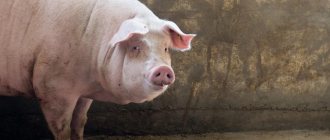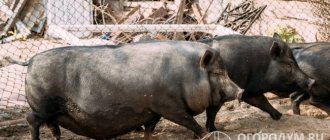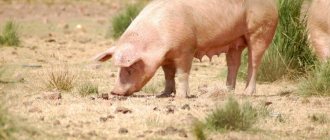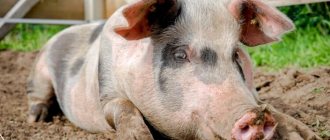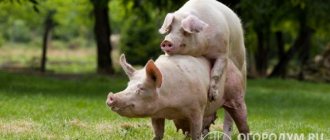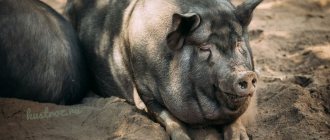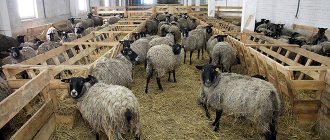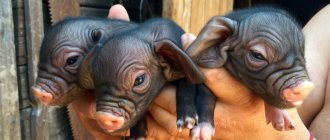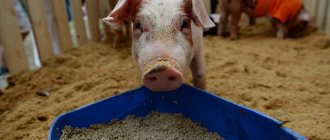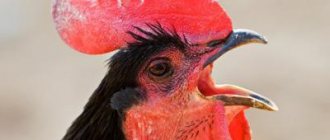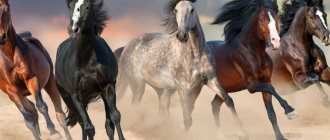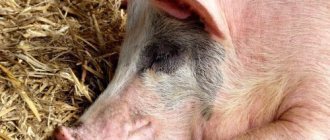Description of the breed
Back in Soviet times, Belarusian collective farms worked on creating this breed.
Belarusian black and white pigs
The result of crossing Landrace, Berkshire, white and animals of this region was the Belarusian black-and-white breed of pigs. The characteristics of these animals are as follows:
- Meat-fat type
- Weight for sows up to 245 kg, for boars 350 kg
- Multiple pregnancy 12 piglets
- Survival rate of young animals 90%
- Daily gain 750g
Constitutional features are represented by black and white coloring, large, slightly drooping ears, a proportional head with a straight profile, a long curved body, a moderately formed ham and strong legs (with a slight x-shaped shape).
Selection work to improve meat performance, survival of young animals, adaptability to production characteristics, and milk production of sows is still ongoing. This breed is used as a basis for breeding new lines. Through intensive and uniform selection, the best representatives of the breed class are selected, and the blood of Estonian pigs, white and others, is infused. Thanks to this, many highly productive lines have already been created.
The positive qualities of these pigs include:
- Their resistance to stress and low tendency to disease.
- A well-developed constitution makes it easy to adapt to living conditions and new types of feeding.
- Sows have increased maternal abilities.
- Piglets, despite their large number in the nest, have good survival rates and average daily gains.
Negative qualities include deficiencies in the structure of the legs and back, which is why not all individuals are adapted to industrial conditions.
The Belarusian black-and-white breed of pigs has a number of positive qualities that are necessary for successful pig breeding. Thanks to this, their popularity is growing every day.
White breeds of pigs: large white and Belarusian
In Russian farming and in general in the CIS countries, white breeds of pigs are considered the most popular, because they produce a large amount of meat and reach good weight. The large white breed appeared in Russia about 100 years ago, and today it is both the main one in our area and an excellent model for breeding new breeds. The white breed was first bred in Great Britain, at that time the pigs were mostly from lard. The Romanesque, Siamese and March breeds were taken as the basis for the new meat pig, because they could boast good growth and a high meat content.
As a result of breeding pigs with other breeds, it became possible to create several popular varieties. In Ukraine, the famous breed is the White Steppe; in Russia, the Russian White is more popular.
It is not by chance that the breed is called a large breed, because with proper care a pig can reach a maximum weight of 200 kg. And the color is white or pale pink. The pig has no folds, and the bristles turned out to be quite smooth and at the same time thick.
The male of the white breed can have a body length of up to 1.9 meters, the female reaches 1.7 meters. The pig's neck is quite noticeable and has sufficient thickness. It is meat because the shape of the pig is quite pronounced. For example, there is a wide chest and back, and a large rear part. Large ears are noticeable. If you look at a photo of a white pig, you can see short legs with large, massive hooves.
Pros and cons of the white breed
There are many farmers who share their views regarding the large white breed of pigs. Some prefer other breeds, others make money exclusively from white pigs. The main advantages of the breed include:
- Calm. The breed turned out to be non-aggressive, the boar and the pig are not in conflict and can safely be together with other breeds. People are also treated normally.
- Not picky about food. The pig does not require special food, so it is considered an omnivore. Both forage and grass are suitable.
- They make offspring quickly. The female can be safely given for mating at the age of 1 year, and the sow can easily bear offspring at this age.
- Fertility. In one farrow, a pig can produce about 12 piglets on average, and the first farrow produces approximately 10 piglets. Moreover, a more experienced sow will produce even more offspring.
- Meat quality. Statistics show that a female at peak age can reach 230 kg, and a male grows up to 340 kg. Moreover, a lot of slaughter weight comes from this - about 82%.
Unfortunately, any animal can have disadvantages, but for many they are not so significant given all the advantages and popularity of the white large breed. The disadvantages include:
- Possibility of obesity . If the pig begins to produce a lot of fat, the properties of the meat will deteriorate. Obesity also contributes to the occurrence of various diseases.
- Fear of cold and extreme heat . Pigs do not like high weather and may not withstand sub-zero frosts or hot sun rays. All because of fair skin and the presence of little hair. A pig in the cold can get pneumonia, and in the summer it can get burns.
The large white pig breed gains weight well, which is why it is chosen by most farmers. For example, with the right diet, you can achieve about 800 grams of weight gain per day . Also, according to statistics, almost all of the born piglets survive, because the large white pig breed produces a large amount of healthy milk.
How to feed correctly?
A big advantage of the large white pig breed is their omnivorous nature. But this does not mean that you can not monitor your diet, because this breed can succumb to obesity. Pigs should not be fed exclusively grain, otherwise the meat will turn out tasteless . To do this, you need to dilute the diet with grass and legumes. Also try to introduce crops such as cabbage, radishes, potatoes, pears, pumpkins, apples, etc. into your daily diet.
Try to provide these crops in winter, since in winter it is not possible to provide grass and similar food. In this case, the pig will receive enough vitamins and minerals. In the absence of green crops, ensure the purchase of a vitamin-mineral complex.
The diet of a standard pig should contain concentrates 65%, potatoes 15%, root vegetables about 12%, silage and hay 4%. Also try to give white pigs about 10 grams of salt per day.
White Belarusian breed of pigs
One of the quite popular varieties of white pig is considered to be the white Belarusian . It is in good demand in Russia and the CIS countries; in Belarus they are seriously engaged in this area and are developing new breeds for maximum efficiency. The history of creation is similar to the standard white breed; the first individuals were brought to Belarus in the 1970s, and since the 1970s a new variety BKB-1 was bred in the country.
This breed was able to achieve good results in weight, for example, a weight of 100 kg was achieved in a period of 170 days instead of 200 days previously. The Belarusian pig boasts reproductive properties, good construction, a small head size and a large final weight. This breed must be provided with the proper temperature in the room.
Similar publications on the topic:
- What to feed a pig correctly: a review of popular products
- Livestock breeding: how many piglets can be born...
- Lice in pigs: a serious illness or a minor problem?
- How to properly build a pigsty on a homestead farm
- What is the yield of pork meat based on live weight?
Pig farming in Belarus
The increase in production volumes of livestock products, including pig breeding, in Belarus is proceeding more and more intensively. For our country, highly developed livestock farming has always been the basis for ensuring food security. Since this industry produces more than 65% of the value of gross agricultural output and the economic well-being of the majority of agricultural workers largely depends on its effective operation. organizations of the republic.
In the republic, all categories of farms produced about 7.0 million tons of milk and more than 1.8 million tons of meat (in live weight) in 2022. Per capita, 750,770 kg of milk and 120,130 kg of meat are produced annually.
The pig breeding industry is of decisive importance in the overall structure of livestock farming.
In the Republic of Belarus there are about 3.1 million pigs in all categories of farms, including 2.7 million in agricultural organizations, of which 390 thousand are in breeding farms.
Breeding is one of the main tasks
Over the past two decades, the pork industry in Belarus has generally functioned successfully. Unlike many countries of the former USSR, breeding centers for breeding animals have been preserved here and are currently actively developing. The country has research and zootechnical institutes engaged in hybrid activities and selection.
Recently, pigs bred on an interbreed basis (crossbreeds and hybrids) have been supplied to meat processing plants from the industrial sector. They are more adapted to production conditions and have better fattening and meat qualities. For this purpose, the world's best genotypes are taken.
Much work in pig farming is carried out to organize adequate feeding, develop requirements for the quality of feed and their components, and improve their structure.
Breed productivity
Belarusian black-and-white pigs are superior in productivity to many other breeds:
- Sows reach physiological maturity when they reach 9-10 months, boars 10-12. During this period, the breeding process can begin; the live body weight of the animal should be from 120 kg. And the number of females fertilized by a young male should not exceed 4 heads per month.
- After mating, the percentage of pregnant females from the livestock reaches 98%. With proper care and proper feeding.
- Pregnancy and childbirth proceed without complications. The number of piglets that can be born from one female can range from 10-12 heads. At the same time, the viable qualities of young people are at a high level of 91-95%. This is due to good maternal qualities and milk production of up to 53 kg of milk per lactation.
- The young animals are kept with the sow for up to 28-30 days, after which fattening begins. When consuming 3.6 feed units per day, a maximum gain of 740 grams can be achieved. And on the 185th day of fattening, the piglets weigh 100 kg.
- Carcasses of slaughtered animals up to 100 cm in length, slaughter yield 65-70%, layer of greasy deposits up to 28 mm, percentage of meat content 58%.
- It is necessary to note the high biological value of meat and its taste characteristics. The most valuable products are those whose muscles contain inclusions of adipose tissue. This property is called marbling. Thanks to this, the meat of these animals is so tasty.
- Marbling is achieved by introducing green feed, root vegetables, and dairy industry waste, which significantly reduces the percentage of grain use. And it improves the economic performance of the farm.
The Belarusian black-and-white breed of pigs, due to its unpretentiousness and productivity, will provide stable growth and high income to the enterprise.
Based on eight different genotypes
The Belarusian meat breed appeared in the late 1990s.
The genes of eight breeds served as the material for its breeding. The breeders carried out intense and painstaking work using the methods of Russian specialists, who also worked hard on the meat representatives. For the first time, pigs that were very similar in both external and qualitative characteristics were crossed.
Distinctive features of the breed include a large litter at each farrowing (up to 12 piglets), high, as tastings show, meat and fat qualities, rapid growth (735-831 g every day), and resistance to infections.
Externally, Belarusian pigs look very large, muscular, with a developed rear part of the body. The head is relatively small, the back is slightly elongated. The skin is almost perfectly smooth and white.
Feedback from livestock farmers
Matvey, 37 years old, Saratov
In my experience, the most unpretentious to feed, resistant to disease, early maturing, prolific and dairy breeds are our proven breeds - Large White and Soviet Meat (SM-1). Of course, buying purebred piglets is not easy or cheap. We took several KB from a private farm - clean, well-fed, active, with a good appetite. Each piglet (two months old) weighed more than 25 kilos. If you buy on the market, then you should not expect any guarantees of compliance with breed standards and vaccinations.
Ekaterina, 44 years old, Kuzbass
If I feed them a complete diet, I like white pigs (promki) the best. In 6 months they reached 100-110 kg live. And the Vietnamese (we have mini pigs) – 40-50 kg. At the same time, the whites ate about 400 kg each, and the Vietnamese 200 kg each. The choice depends on the purpose of raising pigs: for yourself, for sale or as a hobby.
Nikolay, 52 years old, Vinnytsia region
Now real lard is in great short supply, and there is a dominance of meat breeds all around. But I believe that any animal has meat, but only pigs have lard, which is why I like white ones. We specially feed grain and potatoes so that the lard becomes thick (in some places as big as 4 fingers), soft, tasty, whether for yourself or for sale - it goes in great demand.
Advantages and disadvantages
Despite the fact that dark breeds of pigs differ from each other, it is possible to identify common advantages and disadvantages of the group. The benefits of breeding black pigs include:
- High fertility. Most representatives of the group have a good ability to reproduce: sows give birth to an average of 9–11 cubs.
- Unpretentiousness. Black pigs are omnivores and are not capricious in matters of nutrition.
- Good adaptation. Almost all breeds tolerate summer heat and winter cold well.
- Rapid weight gain. Most pigs gain weight quickly and are of impressive size.
- Versatility. The animals produce a good yield of meat and fat and are suitable for breeding work.
Farmers consider the main disadvantages of black pigs to be the animals’ excessive appetite, which is why they often suffer from obesity. In addition, each breed has individual flaws: for example, large black pigs have a pampered constitution.
Origin and registration
The breed owes its origin to the efforts of English farmers who, since the end of the 18th century, crossed local (“marching”) pigs with Mediterranean and South Chinese ones. From dissimilar crossbred animals, the most promising ones were selected for further selection, achieving sufficiently large but early maturing pigs.
The first who managed to achieve significant success in this direction was Joseph Tuley, who presented his Yorkshires at an exhibition in 1851, which had an impressive size and good meat shape. Since 1868, large Yorkshire dogs began to be called the Large White breed, and subsequently active work on its development and improvement was carried out exclusively through breeding methods (without interbreeding).
Large white breed sows on a modern livestock complex
Purebred individuals began to be imported into Russia from England in the mid-19th century. Now the breed is officially registered in the State Register of the Russian Federation (in 1993) as approved for cultivation in all regions of the country.
black pig
Today, farm owners raise pigs for different purposes. Someone simply strives to feed their family with natural homemade meat. Someone receives considerable income from the sale of pork and piglets for breeding. Moreover, if not so long ago the number of breeds bred in our country reached 5-6, today their diversity has increased to several dozen. And the black pig is of particular interest to breeders.
Black breeds of pigs
Features of maintenance and feeding
Breeding Asian pigs should be organized by finding appropriate premises. The relatively small size of mature individuals makes it possible to place them in fairly small blocks.
Content
The pigsty can be equipped with brick, gas silicate blocks or wood.
"Vietnamese" do not need a spacious barn
It is advisable to concrete the floor, since a hard and smooth surface, without cracks, makes the cleaning process more efficient and less energy-consuming. In addition, pigs will not dig in the ground and make dirt. About 2/3 of the territory must be covered with wooden flooring, which will protect them from the cold in the winter. This will be the area reserved for the bedroom. Vietnamese pigs are characterized by rare neatness and cleanliness: they independently zone the space into a rest area and a toilet. A distinctive feature of the pigsties in which “Vietnamese” are bred is the absence of an unpleasant smell of feces.
Cages in a pigsty must have an area of at least 4.5 m²
A closed pigsty should be divided using metal partitions into separate blocks with an area of 4.5 - 5 m². Two mature individuals, a boar or a sow with piglets can freely live in one pen. The passage in the room should be wide enough so that the distance is enough for the unhindered movement of the cleaning cart.
We should not forget about the presence of a ventilation system: lack of fresh air has a negative impact on the health of pigs. An important point is heating: this breed, of course, is quite frost-resistant, but cold temperatures are contraindicated for females after giving birth.
Vietnamese pot-bellied pigs need to be walked daily during the warm season
For summer walking of animals, it is necessary to arrange a space at the rate of 1 hectare per 1 individual. Several logs with a non-uniform surface should be installed in the soil, on which animals can scratch their backs. It is also necessary to equip the walking area with a canopy that will protect the pigs from sunlight or rain. And don’t forget about mud baths: the “Vietnamese” love to spend time in such tanks. Mud helps animals remove blood-sucking insects from the surface of their bodies.
Vietnamese pig takes a mud bath
